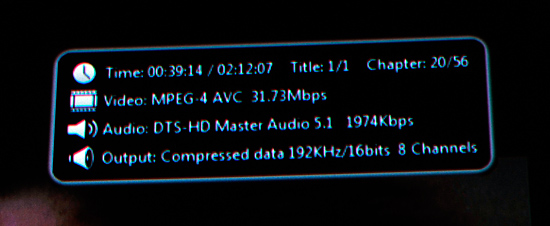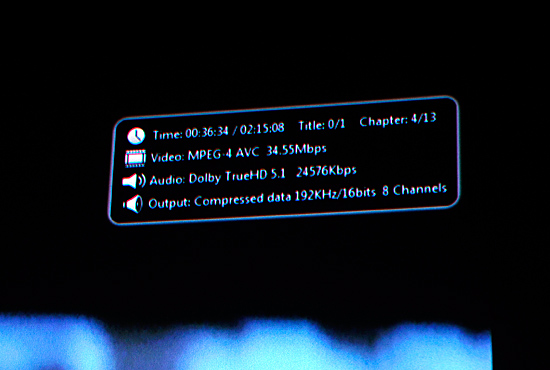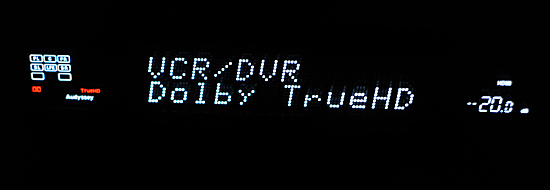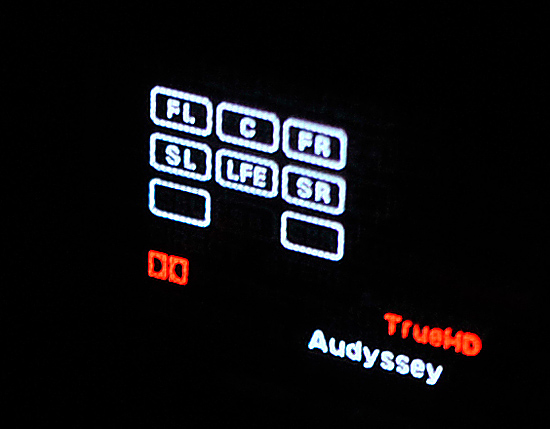Auzentech HomeTheater HD Preview: Bitstreaming True HD/DTS-HD MA
by Anand Lal Shimpi on September 2, 2009 12:00 AM EST- Posted in
- GPUs
The First Attempt: Failure
This was the email I sent Auzentech after spending a full day with the card trying to get it to work:
I've been working with the Auzen Z-Fi HomeTheater HD card for most of the past 24 hours and thus far I have not been able to get it to reliably work in the vast majority of situations. Here's what I've tried:
Under Windows 7 x64
1) On a Zotac GeForce 9300 motherboard with integrated graphics I get no video output from the Auzen card on my Westinghouse LVM-42w2 42" LCD.
2) On an Intel P55 motherboard with GeForce GTX 280 graphics card I get no video output from the Auzen card on my Westinghouse LVM-42w2 42" LCD.
3) On a Zotac GeForce 9300 motherboard with integrated graphics I get no video output from the Auzen card in my home theater setup: Integra DTC-9.8 preprocessor + JVC RS2 projector.Under Windows Vista 32-bit:
1) On an Intel P55 motherboard with GeForce GTX 280 graphics card I am limited to 720p output from the Auzen card on my Westinghouse LVM-42w2 42" LCD. Selecting 1080p simply produces no-signal on the Westinghouse.
2) On an Intel P55 motherboard with GeForce GTX 280 graphics card I get no video output from the Auzen card in my home theater setup: Integra DTC-9.8 preprocessor + JVC RS2 projector.
3) On an Intel P55 motherboard with GeForce GTX 280 graphics card I get no video output from the Auzen card in my secondary home theater setup: Onkyo TX-SR806 receiver + Samsung 50" TV.
4) On an Intel P55 motherboard with GeForce GTX 280 graphics card I get no video output from the Auzen card on my Toshiba 42" Regza LCD TV.In all cases I confirmed that both the LED lights (HDMI in and HDMI out) were illuminated. I tried both an HDMI cable from the GPU to the Auzen card as well as DVI-to-HDMI from the GPU to the Auzen card, neither worked. I even tried the internal HDMI passthrough jumper on the NVIDIA chipset to no avail. I used the drivers off of the CD that came with the card and then installed the updated drivers you sent Gary.
I was ready to give up on it. I went to bed, finished up The SSD Relapse the next day and tried one last thing before I gave up on it again: switch to a non-NVIDIA card.
The one thing both of my test platforms had in common was their NVIDIA graphics using the latest 190 series drivers. I swapped an ATI Radeon HD 4890 into the P55 board, installed its drivers and it worked right away; under both Windows Vista 32-bit and Windows 7 x64.
I’m not sure what the NVIDIA/Auzen incompatibility was, and perhaps switching to an arbitrary older driver would fix it but with a working setup I wasn’t about to try and figure it out. For what it’s worth, the NVIDIA/Auzentech combo did work perfectly on my Dell WFP3008 30” display; too bad it doesn’t have a built in receiver to make that useful.
The Second Attempt: Success
With an AMD GPU on the P55 board everything worked perfectly; I took the system sans case down to my theater, hooked it up and threw on a couple of BDs. I hadn’t seen Die Hard in a while and it has a DTS-HD MA track, so I popped that in to verify that it was working.

There are some UI bugs with the PowerDVD 9 control panel that enables bitstreaming these codecs. You basically have to select your audio output settings twice to get it to work; change your audio output once to something other than bitstreaming then once more to bitstreaming (Non-decoded high-definition audio to external device) to make it work.
Once playing, the thing worked as advertised:

Update: As readers have correctly pointed out it looks like PowerDVD is reporting its output incorrectly, but the card is functioning as intended here. It would be impossible to down-sample the compressed True HD/DTS-HD MA streams without decoding them. It also looks like the audio bitrate in The Hunt for Red October is being incorrectly reported.
Next up we have a Blu-ray of The Hunt for Red October, this time a TrueHD disc:













76 Comments
View All Comments
Jaybus - Friday, September 4, 2009 - link
This is true. I think this should be a software option. It seems they limit bitstream output to 6.144 Mbs, which is the maximum allowed for DVD-Video. This only allows 16-bit 48 kHz sampling for 7.1 surround. Perhaps, with the exception of these high-end audio cards, it is the hardware itself that can't handle more than a 6.144 Mbs audio bitstream over HDMI? Makes the software more compatible with various HDMI implementations? License only allows for DVD-Video quality audio? Not sure.mczak - Wednesday, September 2, 2009 - link
Err, there's no point in using "specialist" high quality hardware for decoding. This is a lossless format, so any decoder adhering to specification will in fact decode it to the exact same uncompressed data. D/A conversion will happen in the receiver anyway so it really doesn't matter where you decode the lossless format.But audiophiles might argue about "better bits" and whatnot whispering words like "jitter"...
micksh - Wednesday, September 2, 2009 - link
Thanks a lot for the article. The essence of the problem is very well formulated.This is exactly what I gathered from months of reading AVSForum. LCPM over HDMI provides you enough resolution for most blu-ray disks even if it is downsampled to 48KHz/16 bit. It is still lossless and can be provided by cheap video cards or motherboards. Not many disks have greater than 48 KHz sample rate and 24 vs 16 bit is like 114 vs 92 db detail level. The difference can't be heard in most environments anyway.
Current Blu-ray PC players just can't get it right with bitstreaming so there is no need to pay ridiculous price for audio hardware. With release of SlyPlayer there will be no need to pay for crap software either.
It is great that the article is appeared on such respectable site.
One question regarding roadmap for motherboard bitstreaming over HDMI. I've heard opposite rumours - LPCM over HDMI can be discontinued because of the need to pay for license. Example - new ATI Radeon 5xxx series are going to lose LPCM over HDMI. Is it true about ATI?
recon300 - Thursday, September 3, 2009 - link
I have to agree. Thanks for the writeup, the issues you highlighted definitely need to be addressed. Great article.Procurion - Wednesday, September 2, 2009 - link
I beg to differ. In a movie room, one built for this environment and set up for it, there is a difference. $250 is high-end which is the emphasis of the article. Subsonics are one of the first thing to go in a compressed format and obvious when compared. There are a lot of people who remember and still listen to lossless-only music and recognize what we're losing when they are converted to what the industry tries to pass off as "indistinguishable" differences in a less than full reproduction.In essence, you can't HEAR the difference, you FEEL the difference. Subsonics and ultra high frequencies can't be heard, true. They are felt.
snarfbot - Wednesday, September 2, 2009 - link
it ultimately depends on your receiver and speakers right?compressed audio does clip the very low and very high frequencies, but most consumer level audio equipment cant even reproduce that part so you wouldnt feel it anyway, even if you could, which im not convinced of, at least in the high range. my mediocre speakers can reproduce painfully high frequencies as it is.
also a good sub can only do around 20hz at best anyway, which is covered just fine by regular dvd's.
so i cant really see what your missing, unless you are talking about bass shakers, you know the things that physically shake the chair your sitting in, which also work just fine with regular compressed audio.
my particular ass for example probably couldn't tell the difference between standard and high definition vibrations.
lol
LTG - Wednesday, September 2, 2009 - link
"you can't HEAR the difference, you FEEL the difference. Subsonics and ultra high frequencies can't be heard, true. They are felt."I'm not that confident in your ability to "feel" ultra high frequencies.
Are you sure they can do anything other than give you a headache or upset your dog?
Fallen Kell - Wednesday, September 2, 2009 - link
"I'm not that confident in your ability to "feel" ultra high frequencies.Are you sure they can do anything other than give you a headache or upset your dog?"
There were several scientific studies on just this subject, and in all of them the answer was yes, we do interpret many of the frequencies that we can not audibly hear. Multiple studies in the infra-sonic frequency ranges have all produces extremely high correlation that humans most certainly do detect infra-sound and interpret it. The high frequency results have not been studied as much, but the studies that I have seen have all shown that there is a very large percentage of people do somehow detect the frequency ranges (one particular study had subjects listening to music which contained a clipped frequency range and music where those clipped frequency ranges were still intact and brain scans were taken during the time. The music with the full range frequency showed much more activity in the brain, which showed that even though the frequency ranges were outside normal audible range, the brain was still interpreting the frequencies).
jigglywiggly - Friday, September 4, 2009 - link
Just get a ps3 and put linux on it, rip it to a smb windows computer. No encrpytion if using anydvd + way freaking easier.MrPoletski - Wednesday, September 2, 2009 - link
It's more than that. You brain identifies the sound as a guitar sound, so you hear a guitar sound - the missing frequencies be damned. As far as you brain is concerned the missing frequencies are just distortion and will require your brain to do a little more work to decipher that it is a guitar sound. But in the end, you will always hear the guitar.That runs with the idea that you dont see and hear the things around you. You see and hear the sights and sounds your brain believes to be around you based on the input it gets from its ears and eyes - i.e. it's interpretation of that.
Having lossy formats wont sound any worse until you have heard the real recording and even then, the difference will be far more noticable ion the experienced fatigue from listening to the music for a length of time.
A tinny radio turned up too loud will tire you out if you are trying to listen to it, a high end hifi would not. In fact, it would be a joy to listen to. Try that tinny radio turned up too loud. You'll soon want to turn it off.